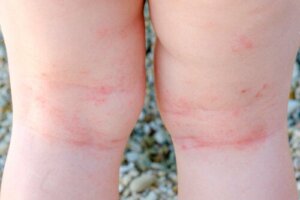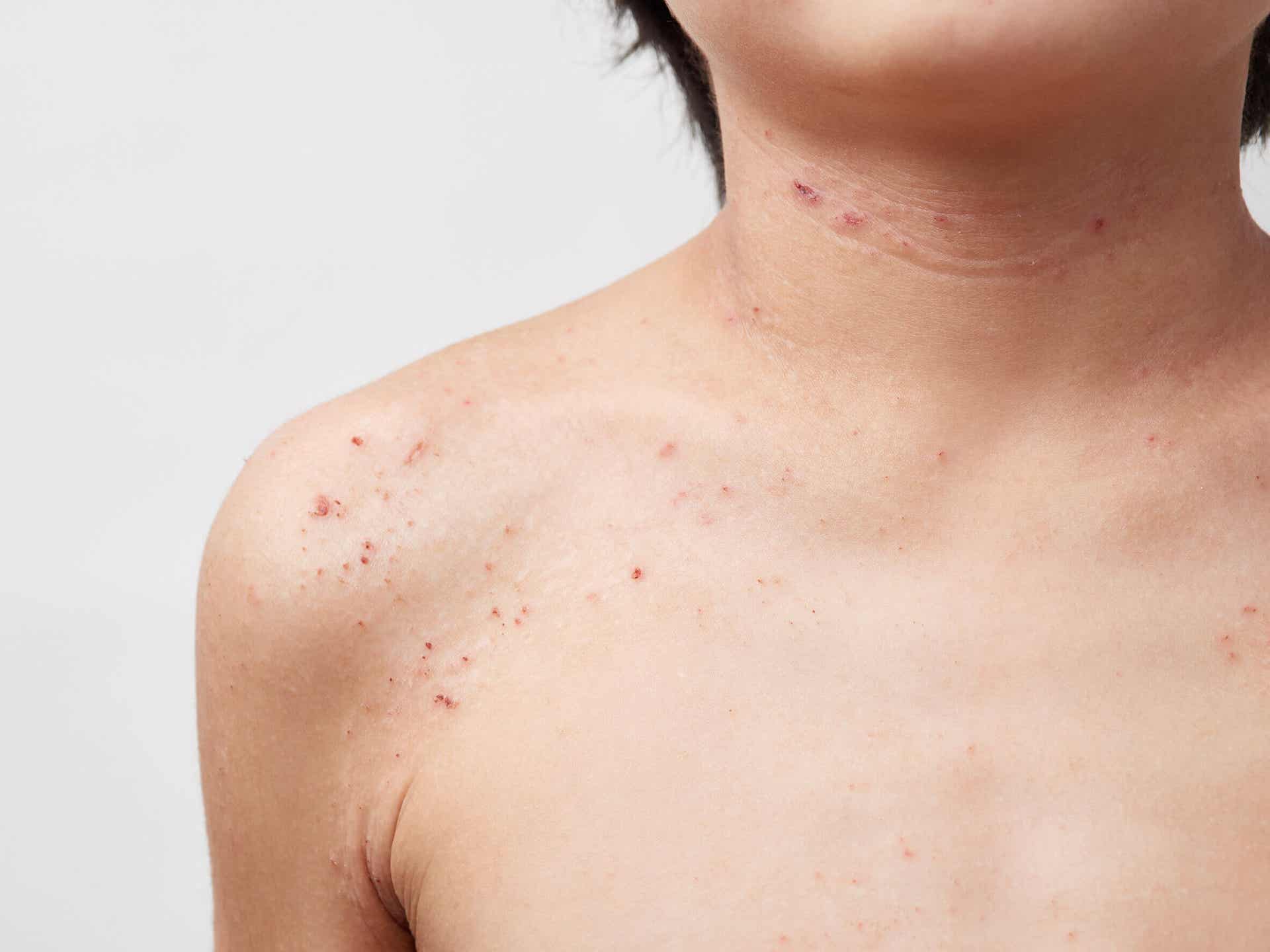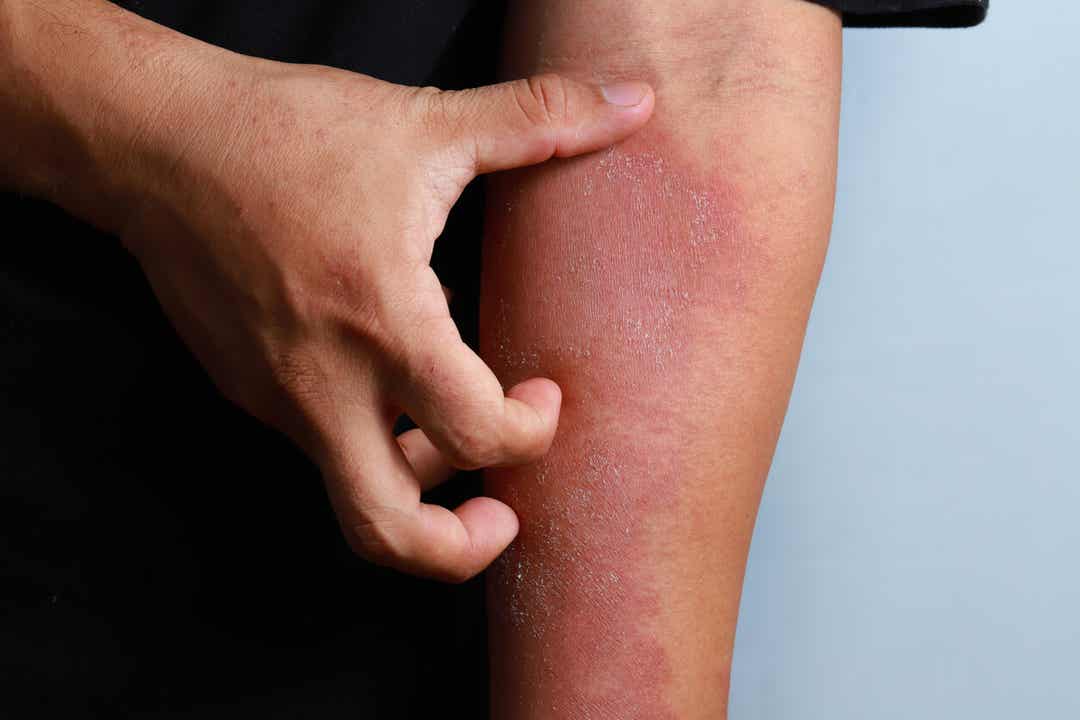10 Questions About Atopic Dermatitis


Written and verified by the dermatologist Maria del Carmen Hernandez
Atopic dermatitis is one of the most common dermatological conditions that can cause discomfort to those who suffer from it. It affects both adults and children, males and females alike. The clinical manifestations cause alterations in a person’s quality of life. However, it doesn’t usually involve risks. Here are ten of the most frequently asked questions about atopic dermatitis.
Ten questions about atopic dermatitis

1. What is atopic dermatitis?
Atopic dermatitis is a chronic inflammatory skin disease. It usually begins in childhood and is characterized by the presence of dry skin. In fact, about 60 percent of cases usually develop during the first year of life.
It most often appears in children (15 – 30 percent), but there may be cases in adults (2- 10 percent). In turn, experts believe there’s a link between atopic dermatitis and other IgE-related disorders such as asthma, food allergies, or allergic rhinitis.
2. Is it contagious?
This is one of the most common questions people have about atopic dermatitis. Although the cutaneous manifestations affect and alter the quality of life of the individual and their family, it’s not contagious.
Although its pathogenesis hasn’t yet been precisely demonstrated, it could be the result of the fusion of the alteration of the cutaneous barrier, immune dysregulation, and environmental and infectious agents. The diagnosis is usually clinical and is based on the characteristics of the lesions together with their location.
3. Is there a relationship between atopic dermatitis and breastfeeding or diet?
A systemic review in The Journal of Allergy and Clinical Immunology concludes that chronic severe atopic dermatitis is partially associated with food allergies. This, therefore, suggests that atopic disease precedes the development of a food allergy. Mostly to products such as peanuts or eggs.
The American Academy of Allergy, Asthma, and Immunology and the European Academy of Allergy and Clinical Immunology recommend exclusive breastfeeding for at least four and up to six months for the primary prevention of allergic diseases.
You may be interested in: 10 Skincare Tips for Babies and Children
4. What areas of the body does it usually affect?
The locations of the lesions vary with age:
- Infants: extensor surfaces (knees, elbows, etc), trunk, neck, face, and scalp.
- Children: flexion surfaces, neck, wrists, and ankles.
- Adolescence and adults: flexion surfaces, hands, and feet.
5. What are the signs and symptoms of atopic dermatitis?
The symptomatology of atopic dermatitis may be different from one person to the next. However, the main and characteristic symptoms are itching and dry skin.
There may be mild or more bright red spots that ooze and scab over when the child scratches them. In turn, these lesions sit on thickened, cracked, and scaly skin. The skin may even be ulcerated, inflamed, and tender.

6. Do the symptoms vary according to the evolution of the disease?
The clinical manifestations of atopic dermatitis depend on the age group and the chronicity of the condition.
- Acute stages: edematous plaques and papules, erythematous and vesicles, or scabs.
- Subacute: erythema, scales, various crusts.
- Chronic: thick plaques with lichenification and scales.
7. Is there a treatment for atopic dermatitis?
When it comes to the treatment of atopic dermatitis, there are four fundamental pillars:
- The avoidance of triggers
- Daily skincare
- Anti-inflammatory treatment
- Complementary therapies
Read also: Allergies to Sweat in Children: Symptoms and Treatment
8. Is sunbathing counterproductive?
There’s no prohibition in this regard. On the contrary, numerous studies have shown a positive influence on eczema when exposed to ultraviolet rays. However, that doesn’t mean that doctors recommend UV exposure as a therapeutic option in allergic diseases.
In fact, exposing acute skin lesions to the sun may cause residual hyperpigmented macules that are difficult to remove in the future.
9. Should certain external agents be avoided?
In the vast majority of cases, the onset occurs in childhood, but the disorder lasts for some time. That is, the disease has relapses and remissions.

10. Are there any limitations or restrictions for those with atopic dermatitis?
Finally, atopic dermatitis isn’t a condition that produces limitations in regard to certain activities or routines. Therefore, people with atopic dermatitis can swim in a swimming pool or in the sea and can expose themselves to the sun (always being careful to avoid sun damage).
Furthermore, there’s no contraindication regarding the practice of sports. However, after exercising or swimming, it’s always best to rinse the skin, dry it with a towel without causing friction, and apply an emollient cream.
In short, we hope we’ve solved your doubts about atopic dermatitis. However, if more questions arise, it’s best to consult a dermatologist for further clarification.
Atopic dermatitis is one of the most common dermatological conditions that can cause discomfort to those who suffer from it. It affects both adults and children, males and females alike. The clinical manifestations cause alterations in a person’s quality of life. However, it doesn’t usually involve risks. Here are ten of the most frequently asked questions about atopic dermatitis.
Ten questions about atopic dermatitis

1. What is atopic dermatitis?
Atopic dermatitis is a chronic inflammatory skin disease. It usually begins in childhood and is characterized by the presence of dry skin. In fact, about 60 percent of cases usually develop during the first year of life.
It most often appears in children (15 – 30 percent), but there may be cases in adults (2- 10 percent). In turn, experts believe there’s a link between atopic dermatitis and other IgE-related disorders such as asthma, food allergies, or allergic rhinitis.
2. Is it contagious?
This is one of the most common questions people have about atopic dermatitis. Although the cutaneous manifestations affect and alter the quality of life of the individual and their family, it’s not contagious.
Although its pathogenesis hasn’t yet been precisely demonstrated, it could be the result of the fusion of the alteration of the cutaneous barrier, immune dysregulation, and environmental and infectious agents. The diagnosis is usually clinical and is based on the characteristics of the lesions together with their location.
3. Is there a relationship between atopic dermatitis and breastfeeding or diet?
A systemic review in The Journal of Allergy and Clinical Immunology concludes that chronic severe atopic dermatitis is partially associated with food allergies. This, therefore, suggests that atopic disease precedes the development of a food allergy. Mostly to products such as peanuts or eggs.
The American Academy of Allergy, Asthma, and Immunology and the European Academy of Allergy and Clinical Immunology recommend exclusive breastfeeding for at least four and up to six months for the primary prevention of allergic diseases.
You may be interested in: 10 Skincare Tips for Babies and Children
4. What areas of the body does it usually affect?
The locations of the lesions vary with age:
- Infants: extensor surfaces (knees, elbows, etc), trunk, neck, face, and scalp.
- Children: flexion surfaces, neck, wrists, and ankles.
- Adolescence and adults: flexion surfaces, hands, and feet.
5. What are the signs and symptoms of atopic dermatitis?
The symptomatology of atopic dermatitis may be different from one person to the next. However, the main and characteristic symptoms are itching and dry skin.
There may be mild or more bright red spots that ooze and scab over when the child scratches them. In turn, these lesions sit on thickened, cracked, and scaly skin. The skin may even be ulcerated, inflamed, and tender.

6. Do the symptoms vary according to the evolution of the disease?
The clinical manifestations of atopic dermatitis depend on the age group and the chronicity of the condition.
- Acute stages: edematous plaques and papules, erythematous and vesicles, or scabs.
- Subacute: erythema, scales, various crusts.
- Chronic: thick plaques with lichenification and scales.
7. Is there a treatment for atopic dermatitis?
When it comes to the treatment of atopic dermatitis, there are four fundamental pillars:
- The avoidance of triggers
- Daily skincare
- Anti-inflammatory treatment
- Complementary therapies
Read also: Allergies to Sweat in Children: Symptoms and Treatment
8. Is sunbathing counterproductive?
There’s no prohibition in this regard. On the contrary, numerous studies have shown a positive influence on eczema when exposed to ultraviolet rays. However, that doesn’t mean that doctors recommend UV exposure as a therapeutic option in allergic diseases.
In fact, exposing acute skin lesions to the sun may cause residual hyperpigmented macules that are difficult to remove in the future.
9. Should certain external agents be avoided?
In the vast majority of cases, the onset occurs in childhood, but the disorder lasts for some time. That is, the disease has relapses and remissions.

10. Are there any limitations or restrictions for those with atopic dermatitis?
Finally, atopic dermatitis isn’t a condition that produces limitations in regard to certain activities or routines. Therefore, people with atopic dermatitis can swim in a swimming pool or in the sea and can expose themselves to the sun (always being careful to avoid sun damage).
Furthermore, there’s no contraindication regarding the practice of sports. However, after exercising or swimming, it’s always best to rinse the skin, dry it with a towel without causing friction, and apply an emollient cream.
In short, we hope we’ve solved your doubts about atopic dermatitis. However, if more questions arise, it’s best to consult a dermatologist for further clarification.
All cited sources were thoroughly reviewed by our team to ensure their quality, reliability, currency, and validity. The bibliography of this article was considered reliable and of academic or scientific accuracy.
- Tsakok T, Marrs T, Mohsin M, Baron S, du Toit G, Till S, Flohr C. Does atopic dermatitis cause food allergy? A systematic review. J Allergy Clin Immunol. 2016 Apr;137(4):1071-1078. doi: 10.1016/j.jaci.2015.10.049. Epub 2016 Feb 18. PMID: 26897122.
- McKenna SP, Doward LC. Quality of life of children with atopic dermatitis and their families. Curr Opin Allergy Clin Immunol. 2008 Jun;8(3):228-31. doi: 10.1097/ACI.0b013e3282ffd6cc. PMID: 18560297.
- Patrizi A, Savoia F, Giacomini F, Tabanelli M, Gurioli C. The effect of summer holidays and sun exposure on atopic dermatitis. G Ital Dermatol Venereol. 2009 Aug;144(4):463-6. PMID: 19755951.
- Langan SM, Irvine AD, Weidinger S. Atopic dermatitis. Lancet. 2020 Aug 1;396(10247):345-360. doi: 10.1016/S0140-6736(20)31286-1. Erratum in: Lancet. 2020 Sep 12;396(10253):758. PMID: 32738956.
- Lee KS, Rha YH, Oh IH, Choi YS, Kim YE, Choi SH. Does Breast-feeding Relate to Development of Atopic Dermatitis in Young Korean Children?: Based on the Fourth and Fifth Korea National Health and Nutrition Examination Survey 2007-2012. Allergy Asthma Immunol Res. 2017 Jul;9(4):307-313. doi: 10.4168/aair.2017.9.4.307. PMID: 28497917; PMCID: PMC5446945.
This text is provided for informational purposes only and does not replace consultation with a professional. If in doubt, consult your specialist.








